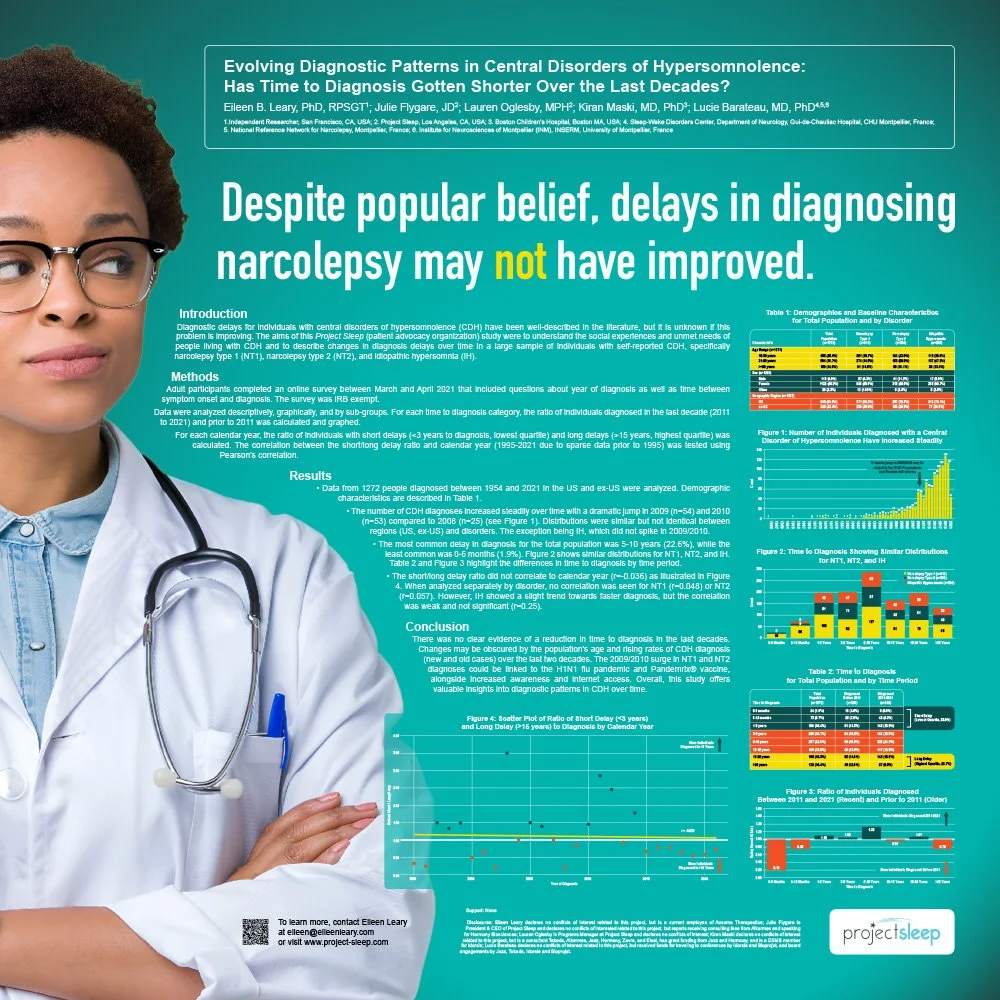Thorpy MJ, Krahn LE, Bogan RK, Corser BC, Shapiro C, Chen D, Chhabra A, Leary EB, Tabuteau H. Impact of AXS-12 on Symptom Severity and Functional Impairment in Narcolepsy: Results from the Phase 3 SYMPHONY Trial. Sleep 48(supp|_1) – Accepted.
Bogan RK, Thorpy MJ, Krahn LE, Corser BC, Shapiro C, Chen D, Chhabra A, Leary EB, Tabuteau H. ENCORE: Topline Results of a Phase 3 Open-Label Extension and Randomized Withdrawal Trial of AXS-12 in Narcolepsy. Sleep 48(suppl_1) – Accepted.
Thorpy MJ, Kant A, Harper K, Leary EB, Eglit G, Floam S, Tabuteau H. Residual Symptom burden in Patients With Narcolepsy Satisfied With Treatment: Subgroup Analysis From The CRESCENDO Survey. Sleep 48(supp|_1) – Accepted.
Dias B, Mejia G, Lomba S, Lemer A, Keenan S, Mah C, Leary EB, Mignot E, Pelayo R. Longitudinal Effects of Sleep Education on Undergraduates and Graduates Students: Insights from Stanford University's Dement's Sleep and Dreams. Sleep 48(suppl_1) – Accepted.
Leary EB, Van Dongen HPA, Drake C, Bogan R, Jaeger J, Streicher C, Tabuteau H. Daily solriamfetol improved difficulty with memory and thinking in people with obstructive sleep apnea and excessive daytime sleepiness experiencing such difficulty: a plain language summary. Postgraduate Medical Journal – In Revision.
Husain AM, Zee PC, Leary EB, Fuller DS, Candler S, Whalen M, Gow M, Bae CJ. Experiences of People With Narcolepsy Who Switched From Sodium Oxybate to Low-Sodium Oxybate: A Plain Language Summary. Future Neurology – In Revision.
Invited Panel Member
Participated in doctoral student professional development seminar on non-academic career paths
Flygare J, Oglesby L, Parthasarathy S, Thorpy MJ, Mignot E, Leary EB, Morse AM. Social support and isolation in narcolepsy and idiopathic hypersomnia: An international survey. Sleep Med. 2025 Jan;125:65-73. DOI: 10.1016/j.sleep.2024.11.013. Epub 2024 Nov 12. PMID: 39561673.
Leary EB*, Van Dongen HPA*, Drake C, Bogan R, Jaeger J, Rosenberg R, Streicher C, Tabuteau H. Results of the Solriamfetol's Effect on Cognitive Health in Apnea Participants During a Randomized Placebo-Controlled Study (SHARP): A Randomized Placebo-Controlled Double-Blind Repeated-Measures Crossover Phase IV Clinical Trial of the Effect of the Wake-Promoting Agent Solriamfetol on Cognitive Function in OSA With Excessive Daytime Sleepiness and Cognitive Impairment. Chest. 2024 Nov 9: S0012-3692(24)05470-9. DOI: 10.1016/j.chest.2024.10.050. Epub ahead of print. PMID: 39528111. (* equal contribution)
Thorpy MJ, Krahn L, Bogan RK, Corser B, Shapiro C, Chhabra A, Leary EB, Tabuteau. AXS-12 for the Treatment of Narcolepsy: Topline Results From the Phase 3 SYMPHONY Trial. Journal of Sleep Research, Volume 33, Issue S1, Sept 2024.
Thorpy MJ, Kant A, Harper K, Leary EB, Parks G, Floam S, Tabuteau H. CRESCENDO: Results from a Survey of Symptom Burden and Quality of Life in Patients with Narcolepsy Type 1 Journal of Sleep Research, Volume 33, Issue S1, Sept 2024.
Van Dongen H, Leary EB, Eglit G, Drake C, Bogan R, Jaeger J, Tabuteau H. Effects of Solriamfetol on Cognition in Obstructive Sleep Apnea With Excessive Daytime Sleepiness and Impaired Cognition. Journal of Sleep Research, Volume 33, Issue S1, Sept 2024.
This study analyzed data from 1272 adults with self-reported central disorders of hypersomnolence (CDH) who completed a Project Sleep online survey between March and April 2021 that included questions about year of diagnosis as well as time between symptom onset and diagnosis.
The number of CDH diagnoses increased steadily over time with a dramatic jump in 2009 / 2010. For each calendar year, the ratio of individuals with short delays (<3 years to diagnosis, lowest quartile) and long delays (>15 years, highest quartile) was calculated. This short/long delay ratio did not correlate to calendar year (r=-0.036). Overall there was no clear evidence of a reduction in time to diagnosis in the last decades. Changes may be obscured by the population’s age and rising rates of CDH diagnosis (new and old cases) over the last two decades. The 2009/2010 surge in NT1 and NT2 diagnoses could be linked to the H1N1 flu pandemic and Pandemrix® vaccine, alongside increased awareness and internet access.
Leary EB, Flygare J, Oglesby L, Maski K, Barateau L. Evolving Diagnostic Patterns in Central Disorders of Hypersomnolence: Has Time to Diagnosis Gotten Shorter Over the Last Decades? Sleep 47(suppl_1), May 2024 (Late Breaking Abstracts).
Van Dongen H, Leary EB, Eglit G, Drake C, Bogan R, Jaeger J. Solriamfetol on Cognition in Obstructive Sleep Apnea with Excessive Daytime Sleepiness and Impaired Cognition. Sleep 47(suppl_1) A432-433, May 2024, DOI: 10.1093/sleep/zsae067.01007.
Macfadden W, Leary EB, Fuller DS, Kirby MT, Roy A. Effectiveness and optimization of low-sodium oxybate in participants with narcolepsy switching from a high-sodium oxybate: data from the SEGUE study. J Clin Sleep Med. 2024 Apr 23. DOI: 10.5664/jcsm.11182. PMID: 38652499.
